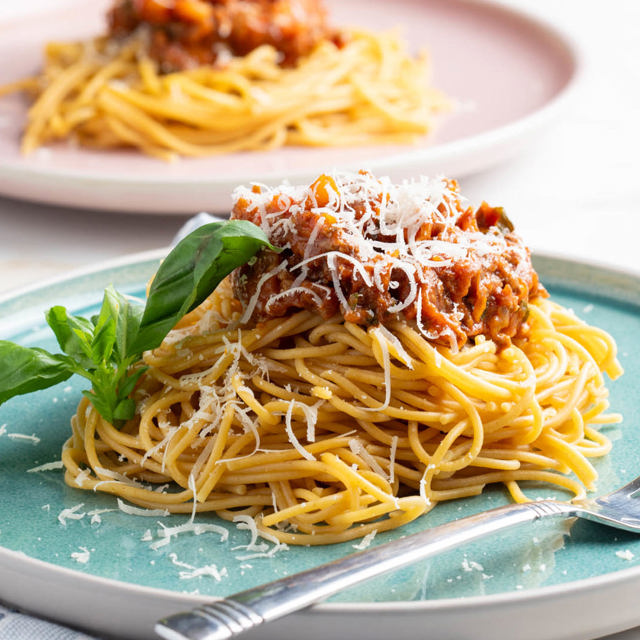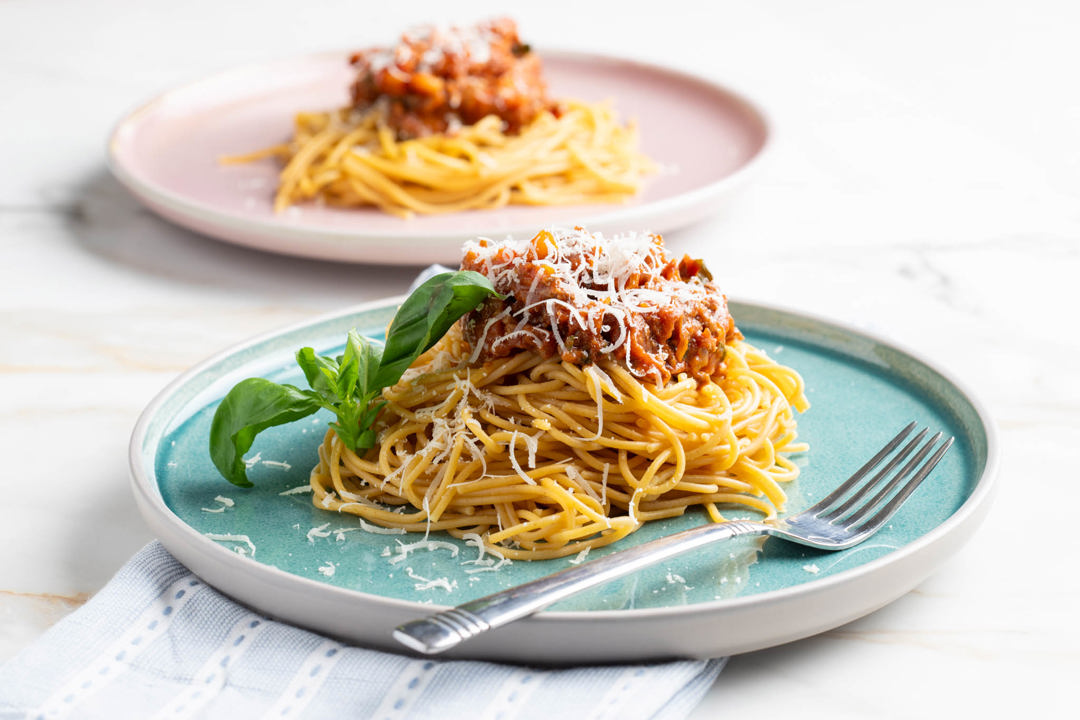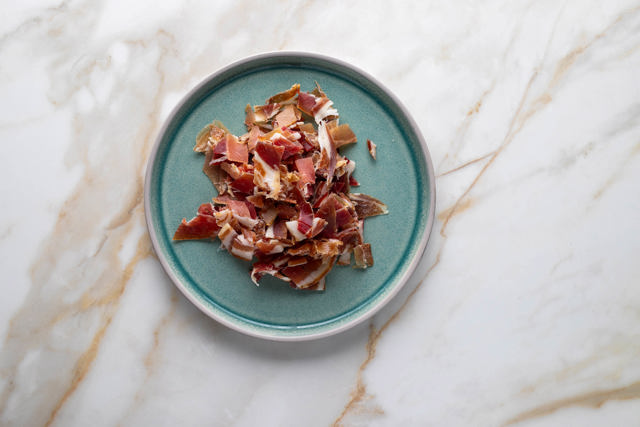Every family in Australia has a different recipe they use to cook this dish - it's a staple go-to weeknight dinner that satisfies the fussiest kids and adults alike. You can knock it out in under half an hour or let it simmer for a little longer if you have the time!
This is my best ever recipe for Bolognese sauce. It's not particularly complex, but I also have a simple version ideal as a quick weeknight dinner which you should take a look at. See my Quick and Easy Bolognese Sauce recipe for a speedy alternative!
Perfect to serve over pasta, as a lasagne filling, as a jacket potato topping or even as leftovers on some toast.
Spaghetti Bolognese's roots are in the Italian "ragu alla Bolognese," a meat sauce from the city of Bologna. Ragu alla Bolognese is a little different though; for example, it's usually eaten with tagliatelle pasta, not spaghetti, and milk is often added.
For me, I grew up eating this dish. Oftentimes when I went to friends' places, I'd get served their families take on the humble old "spag bol" as us Aussies often call it because parents know it's something that kids will eat, and I'm yet to meet an adult who doesn't like tucking into a bowl! My mum also made it at least every other week so we grew up with it on regular rotation.
For the fussy eaters, this recipe has the benefit of having a lot of vegetables hidden in it which also helps build the fantastic flavour base in the sauce.
You should also consider trying to make a ragu, which is very similar to Bolognese sauce, but it's cooked for a longer time, bringing out even more flavour.
What is Spaghetti Bolognese?
Spaghetti Bolognese, aka "spag bol", is a popular Italian inspired pasta dish consisting of a rich tomato-based meat sauce served over cooked spaghetti. It's a staple in many families, many of which have their own take on this dish.
Spaghetti Bolognese ingredients
- Vegetables I use a variety of vegetables to provide a fantastic savoury base; celery, carrots, onion.
- Pancetta this is optional but it adds a great flavour. This dish is fantastic without it but this takes it to the next level!
- Mince this tastes great with a mixture of pork and beef, or pork and veal. I'd suggest a ratio of 50/50 to 75/25 beef to pork. Don't use a super lean mince here, you want some fat for flavour. I've found that 80/20 to 90/10 mince works best.
- Flavourings using garlic, wine, Worcestershire and beef stock build upon the foundation of the mince and vegetables. Try experimenting with your own favourite flavours to see how you can put your own spin on this!
- Herbage you can optionally add dried basil or oregano early in the cooking process, or some finely sliced basil just before serving. Bay leaves also bring a great savoury note.
- Tomatoes the base of the sauce is tomato. Always use the best quality you can afford. I like the texture of diced tomatoes, but passata also works well; if you use whole canned tomatoes make sure you break them up.
How to Make the Best Spaghetti Bolognese: Step-by-Step Guide
Mise en place – prepare all of the ingredients according to their instructions; dice the pancetta (1) and vegetables (2).
Sautee the pancetta in the oil (1) until the pancetta fat renders out and the pancetta is golden (2)
Remove the pancetta and then sautee the onions, carrots, celery and basil stem in the pancetta fat
Add the mince (1) and brown (2)
Add garlic, tomato paste and basil stems, and stir until the garlic is fragrant and the tomato paste is starting to stick - about 30 seconds
Deglaze the pan by adding the wine and scrape the bottom of the pan – lots of great flavour there!
Let the wine reduce until it's mostly gone then add the tomato, Worcestershire and stock
Simmer for at least 15 minutes, then serve on top of spaghetti and top with parmesan cheese
Best Side Dishes for Spaghetti Bolognese
Spaghetti Bolognese is a complete meal by itself, but you can make the meal more of an occasion with:
- An Italian-style garden salad
- Garlic bread
- Focaccia bread
- A simple Italian dessert, like Tiaramisu
Spaghetti Bolognese is meant to be served with Spaghetti pasta – it's in the name! But you can use any other pasta you have on hand or fancy; it works equally well with fettuccine, penne or conchiglie. Avoid using very thin pasta like angel hair.
This is one pasta dish that I think works better with the sauce on top of the pasta, but you can absolutely combine the pasta and Bolognese sauce in a pan to finish it.
Oh... and you can't forget the parmigiano reggiano aka parmesan cheese. It takes the sauce to the next level! Wherever you can, use a decent Italian parmigiano – not all cheese are created equal.
Leftovers
Spaghetti Bolognese freezes well, so you can easily make a larger quantity and freeze the leftovers!
Leftovers are also great for:
- Lasagne
- On top of some toast for a simple dinner
- Quesadilla filling – sandwiched between two flour tortillas along with some cheese as the filling and cooked in a frying pan
- Stuffed vegetables – capsicum/bell peppers, eggplant and zucchini
- As a baked potato topping along with some grated cheese
- Taco filling
- As a toasted sandwich filling
The sauce and pasta can easily be made ahead and reheated.
Sauce on top, or mixed through
The majority of the time I've eaten this, the sauce is on top of the pasta, including at restaurants. Ultimately it comes down to your preference, but if you'd like to sauce the pasta you can.
Instructions for saucing the pasta
Once the sauce is cooked and the pasta is mostly cooked, add 1 cup of the sauce per person to an appropriately sized pan. When the pasta is just before al dente, add to the pan with the Bolognese sauce using a spider or tongs, bringing pasta water along with you. Use tongs to thoroughly incorporate the meat sauce into the pasta and finish cooking the pasta, adding more water as needed to keep the sauce loose.
What's the difference between Spaghetti Bolognese and authentic Italian ragù alla Bolognese?
There are some key differences between spaghetti Bolognese and an authentic ragù alla Bolognese:
- Pasta - ragù alla Bolognese is traditionally served with wider, flat pasta like tagliatelle or pappardelle, which better holds the thick sauce.
- Tomato - spaghetti Bolognese usually has a more tomato-heavy sauce. Traditional ragù uses only a small amount of tomato, often just tomato paste.
- Dairy - ragù often includes milk or cream, which is simmered into the sauce for richness and to tenderize the meat. This is rarely used in Spaghetti Bolognese.
- Herbs - traditional ragù uses little to no herbs, focusing instead on the flavours of the meat and vegetables.
- Texture: ragù alla Bolognese is generally thicker and less saucy.
How to put your own spin on Spaghetti Bolognese
There is honestly so much to this recipe that you can do to put your own twist on it. Here's some ideas:
- Don't like basil? Try using thyme or rosemary.
- Not a fan of wine? Use chicken stock instead.
- Try different mince combinations, for example pork and chicken.
- If you have time, simmer the sauce for longer. It'll bring the flavour out, and you can always add some water to thin it out if needed. Just make sure to stir it regularly so it doesn't catch.
- Add different vegetables in; try some grated zucchini or mushroom!
- Growing up, my mum always added kidney beans to bulk the meal out. I still love this, to the recipe below add 2x 400g tins of drained and rinsed kidney beans along with an extra 400g tin of tomato.
- Add peas and corn for some colour and more veg.
- Grate a little dark chocolate into the sauce. This adds a very deep and rich flavour; it shouldn't taste like chocolate but adds a hint of bitterness.

Spaghetti Bolognese
| Prep | Cook | Total |
|---|---|---|
| 15 mins | 20 mins | 35 mins |
- 4 tbsp olive oil
- 120g thick sliced pancetta, diced optional but recommended
- 3 onions, diced
- 3 carrots, quartered and diced
- 3 celery sticks, diced
- 1kg beef mince or use a mixture of beef and pork - see note 1
- 5 cloves of garlic, minced if you love garlic, use more to taste!
- 50g (3 tbsp) tomato paste
- 250ml / 1 cup of wine see note 2
- 1 beef stock pot, or 4 beef stock cubes, crushed or use 250ml of beef stock - see note 3
- 3x 400g can diced tomatoes or passata see note 4
- 4 dried bay leaves
- 4 tsp Worcestershire sauce
- Chilli flakes, optional
- Sugar, to taste see note 5
- 1 tbsp quality aged balsamic vinegar
- 20g Basil leaves, sliced, stems reserved
- Salt & pepper, to taste
- Freshly grated parmesan cheese
- 400g spaghetti or other dried pasta
- Fresh basil leaves
- Heat oil in a large frying pan or Dutch oven over medium heat.
- Cook pancetta - add the diced pancetta and fry until golden and crisp – about 3-4 minutes – and using a slotted spoon remove from the skillet, leaving the fat behind.
- Cook the vegetables - add the onions, carrots, celery and basil stalks and cook for 10 minutes, stirring regularly. You don't want to colour the vegetables, but slowly sweat their water out.
- Cook the mince - increase heat to medium high and add the mince. Stir regularly and use your spoon or spatula that you're cooking with to break the mince up into small pieces. Cook for about 6-10 minutes until the mince is well browned and broken into small pieces.
- Add garlic and tomato paste - add the minced garlic and tomato paste and stir it through. Stir every 10 seconds until the garlic is very fragrant – should be about 30 seconds – and then add the wine and beef stock pot/crushed stock cubes.
- Deglaze - use the back of your spoon or spatula and scrape the bottom of your pan to deglaze and remove all the flavourful fond from the bottom of the pan.
- Add tomato and aromatics - when the wine is mostly reduced, add the tomato, bay leaf, Worcestershire sauce and return the pancetta along with any fat they have released. Bring to a boil, stirring frequently, then reduce heat to medium.
- Cook sauce - simmer gently for 20 minutes, uncovered. Stir it occasionally while it's simmering and if looks a little dry, add a splash of water to ensure it doesn't stick to your pan. For a better result, you can cook the sauce for longer; see notes for details.
- Cook pasta - when the sauce is mostly done, cook the pasta according to packet instructions.
- Adjust seasoning - just before you're ready to serve, adjust the seasoning. Use some sugar to offset the bitterness of the tomato, add some chilli flakes if you want the kick, add the balsamic, basil leaves and salt and pepper. Stir thoroughly whenever you add seasonings before tasting again – and take it slow, you can always add more but you can't take it out!
- Serve - remove the bay leaves and basil stems and serve with spaghetti or pasta of your choice, topped with the Bolognese sauce, plenty of parmesan cheese and a little extra basil.
- Mince - This tastes great with a mixture of pork and beef, or pork and veal. I'd suggest a ratio of 50/50 to 75/25 beef to pork. Use a ratio of 80/20 to 90/10 of lean to fat for the best result.
- For wine, use red or white – both work great! Red is more traditional, but I love the taste that a good white brings with it. Remember, if you wouldn't drink it, don't cook with it!
- Beef stock pot - you can get concentrated beef stock pots which bring great flavour. You can also get a good result using beef stock cubes. Alternatively, use 1 cup of beef stock.
- Tomato – Preferably use either diced/crushed tomato or passata. If using whole tomatoes, make sure you break them up with your hand before adding them, or crush them with your spoon.
- Sugar – depending on how sweet your tomatoes are, you might need to add some sugar to offset the tartness of them. The dish should not taste sweet, but balanced.
- Long cook (oven) - cook, uncovered in the oven for 2 - 2.5 hours at 150C. Stir every 15 minutes and if it's starting to catch on the bottom of the pan add a little water and stir it through.
- Long cook (stove) - cook at a medium low temperature (4/10 on my stove) with the lid mostly on. Stir every 10 minutes until the sauce has thickened and reduced - around 1.5 hours. If it starts to stick to the bottom of the pan, add a splash of water.
- Simple version - if you want to try a simpler Bolognese recipe, try my Quick and Easy Bolognese Sauce with Pasta






























